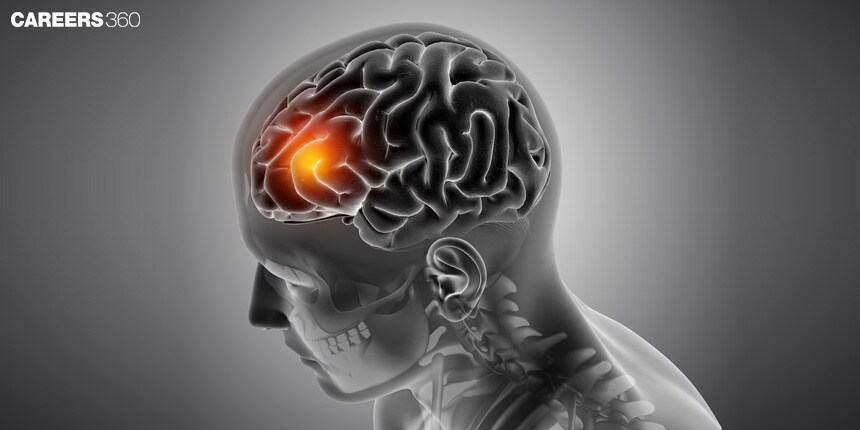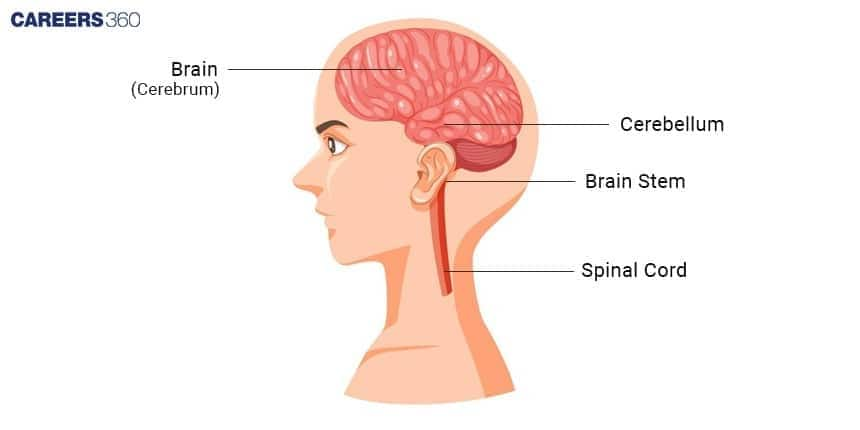Central Nervous System: Description, Development, Structure, Function, Diagram
The central nervous system (CNS), composed of the brain and spinal cord, is the primary control centre that regulates body activities, processes sensory information, and ensures homeostasis. CNS functions through specialised neurons and glial cells, protected by meninges, cerebrospinal fluid, and the blood–brain barrier. This guide covers components, neural pathways, reflex actions, protection, disorders, diagrams, FAQs, and NEET MCQs.
This Story also Contains
- What Is the Central Nervous System (CNS)?
- Components of the Central Nervous System
- Cells of the Central Nervous System
- Function of the Central Nervous System
- Protection Of The Central Nervous System
- Disorders Of The CNS
- Central Nervous System NEET MCQs (With Answers & Explanations)
- Recommended Video On ‘Central Nervous System’

What Is the Central Nervous System (CNS)?
The central nervous system consists of the brain and spinal cord and serves as the main control centre of the body. It processes all sensory information, provides responses, and maintains homeostasis.
Components of the Central Nervous System
There are two prime parts of CNS. They include the brain and the spinal cord.
Brain
The brain is divided into three major parts:
Cerebrum
Cerebrum is the largest part and is responsible for higher brain functions such as thought, action, and sensory processing.
The lobes of cerebrum are frontal, parietal, temporal, occipital.
Each lobe has well-defined functions, such as reasoning, perceiving sensations, and perceiving visions.
Cerebellum
It controls balance, coordination, and fine muscle control.
Coordinates involuntary motions and maintains posture.
Brainstem
Further divided into midbrain, pons, and medulla oblongata.
It regulates all vital activities, like the heartbeat, breathing, and sleep cycles.
Joins the brain with the spinal cord.
It controls automatic functions.
Spinal Cord
The spinal cord is composed of cervical, thoracic, lumbar, sacral, and coccygeal regions.
Carry information between the brain and the rest of the body
Controls the reflex actions.

Cells of the Central Nervous System
There are two kinds of cells within the central nervous system:
Neurons
Cell Body (Soma): Contains the nucleus and metabolic machinery.
Dendrites: Receive the signals from other neurons.
Axon: Conducts electrical impulses away from the cell body.
The types of neurons are:
Sensory Neurons: Carry sensory information into the CNS
Motor Neurons: Carry signals from the CNS to muscles and glands.
Interneurons: Connect neurons, including other interneurons, within the CNS.
Glial Cells
Glial cells provide structural support and nourishment
They also provide protection to neurons
The types of glial cells are:
Astrocytes: Support and protection of neurons, maintenance of the blood-brain barrier.
Oligodendrocytes: Formation of myelin in the CNS
Microglia: Immune defence in the CNS
Ependymal Cells: Line ventricles.
Function of the Central Nervous System
The functions of the CNS include:
Synaptic Transmission
A synapse includes the release of neurotransmitters by a presynaptic neuron, crossing the synaptic gap and binding to receptors of the postsynaptic neuron.
Chemical messengers, for example, dopamine, serotonin, and acetylcholine, modulate different CNS functions.
Reflex Actions
A reflex action tends to involve sensory input, integration in the spinal cord, and motor output without the inclusion of the brain.
Examples are the patellar reflex and the withdrawal reflex to painful stimuli, both being of significance for rapid protective responses.
Protection Of The Central Nervous System
The protection of the central nervous system is done by:
Meninges
Dura Mater: Tough outer layer.
Arachnoid Mater: Middle web-like layer.
Pia Mater: Delicate inner layer adhering to the CNS surface.
Cerebrospinal Fluid (CSF)
Production, circulation, and CSF function.
Produced by the choroid plexus and flows through the ventricles and the subarachnoid space, cushioning the CNS, and removing waste.
Blood-Brain Barrier (BBB)
A selective barrier comprises endothelial cells, astrocytes, and pericytes, which together protect the CNS from a wide range of injurious molecules.
Disorders Of The CNS
The various disorders have characteristic symptoms and causes, with treatments ranging from medication for symptom management to physical therapy. The disorders of the CNS are:
Multiple Sclerosis
Demyelination—causing such symptoms as muscle weakness or blindness.
Parkinson's Disease
Disruption in motor control due to the deficiency of dopamine; characterised by tremors and rigidity.
Alzheimer's Disease
From memory loss to the general cognitive decline of the patient.
Central Nervous System NEET MCQs (With Answers & Explanations)
Important questions asked in NEET from this topic are:
CNS and its components (Brain and Spinal Cord)
Function of CNS
Practice Questions for NEET
Q1. The somatic neural system
is the site of information processing and control
relays impulses from the CNS to skeletal muscles
is further classified into the sympathetic neural system and parasympathetic neural system
transmits impulses from the CNS to the involuntary organs and smooth muscles of the body
Correct answer: 2) relays impulses from the CNS to skeletal muscles
Explanation:
The PNS is divided into two divisions called the somatic neural system and the autonomic neural system. The somatic neural system relays impulses from the CNS to skeletal muscles. The autonomic neural system transmits impulses from the CNS to the involuntary organs and smooth muscles of the body. The autonomic neural system is further classified into the sympathetic neural system and parasympathetic neural system. The somatic neural system relays impulses from the CNS to skeletal muscles.
Hence, the correct answer is option 2) relays impulses from the CNS to skeletal muscles.
Q2. Myelinated nerve fibres are found in
Spinal nerves
Cranial nerves
Autonomic nervous system
Both a and b
Correct answer: 4) Both a and b
Explanation:
There are two types of axons, namely, myelinated and unmyelinated. The myelinated nerve fibers are enveloped with Schwann cells, which form a myelin sheath around the axon. The gaps between two adjacent myelin sheaths are called nodes of Ranvier. Myelinated nerve fibers are found in spinal and cranial nerves. Unmyelinated nerve fiber is enclosed by a Schwann cell that does not form a myelin sheath around the axon and is commonly found in autonomous and somatic neural systems.
Hence, the correct answer is option 4) Both a and b.
Q3. Approximately, how many neurons are found in the human brain ?
10 million
100 billion
10 billion
1 million
Correct answer: 2) 100 billion
Explanation:
A neuron is a microscopic structure composed of three major parts, namely, cell body, dendrites and axon. Approximately 100 billion neurons are found in the human brain. The cell body contains cytoplasm with typical cell organelles and certain granular bodies called Nissl’s granules.
Hence, the correct answer is option 2) 100 billion
Also Read:
Recommended Video On ‘Central Nervous System’
Frequently Asked Questions (FAQs)
The CNS processes and integrates sensory information and responses, and controls most activities of the body and mind.
Neurons communicate by synapses, where neurotransmitters are released to carry on the signal across cells.
Symptoms might include the loss of movement, sensation, or function below the level of injury.
Protective measures include helmets, avoiding smoking, a healthy diet, and keeping a regular level of exercise.
Currently under development are studies on neuroplasticity, stem cell therapy, MRI technologies, and brain-computer interfaces.